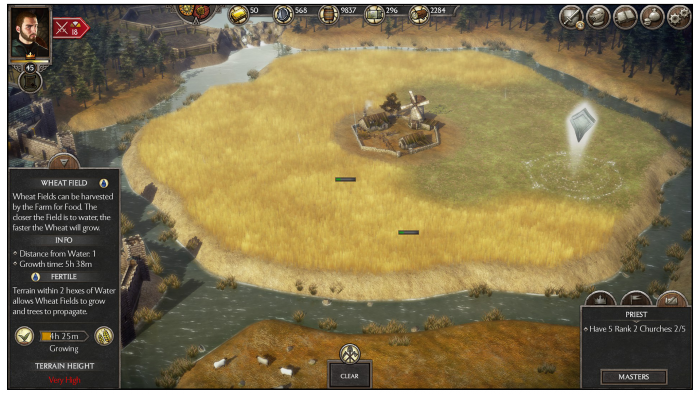Developers Blog 4
Dev Blog 4 – How Water works
Water is one of the most integral parts of a thriving realm in Total War Battles: KINGDOM. So we’re here to help with this latest blog post which explains how water behaves in the game, what pitfalls you should avoid and how you can utilize water to maximise your resources.
The most fundamental characteristic about water in the game is that it flows downhill, from higher to lower terrain. Its journey begins from one of the 3 water sources at the top of the map like the one in the image below.
From there it flows through the realm until it eventually reaches the sea at the bottom of the map. As lord of the realm, you can alter the route of the water as you see fit. You can create rivers to irrigate your crops and forests or form lakes for your fishing grounds. You can also divert rivers to make room for pastures or a new town.
Ideally, the water will follow the route that you set for it, but if its way gets blocked, the water will eventually find a way out – causing havoc in your peaceful realm. If you block a river with a dam, for example, and there is no secondary route for the water to escape, it will gather behind the dam until it bursts. The excess water will then flood the area beyond the dam– potentially destroying any trees, roads or wheat fields in its path.
The water in the game does not update in real time, but rather every few minutes. This gives the player a chance to react to what the water is doing and prevent possible floods.
If, for example, you blocked the waters outflow from a lake, the water level will rise steadily every few minutes. When the dam is cleared or bursts, the more water that has gathered, the more land will be covered.
If you want to change the course of a river by blocking off the water briefly, let’s say a minute or two, since there hasn’t been any (or not much) excess water building up behind the dam, your new river bed will fill up gradually.
There’s a secondary effect of blocking water from a source – the water in the river bed or lake beyond the dam will immediately evaporate (except for deep water, which only be found in lakes). As a result, you’ll be left with wetlands, which we’ll talk about more in depth below.
If you dry out a lake that contains deep water, these will not turn into wetland right away, instead the water will evaporate over time.
Which brings us to the seasonal effect on water. As you might imagine, water behaves slightly differently depending on the season. In spring everything is business as usual. Come summer, evaporation is faster and you might notice that your rivers start receding.
The typical English autumn brings plenty of rain. In the game this can be seen by reservoirs of water filling up faster. In winter, all the water in the realm (except sea water) turns to ice.
You might be asking yourself why you should bother with all this. The answer is simple – water brings life, and as such it affects your resource management in multiple ways.
The most obvious food source connected to water is, of course, fish. Fish will only appear in deep water and can be caught by fisherman from a harbour that’s on the same stretch of water. During the transition from autumn to winter, fishing spots have a 50% chance to turn into fishing huts that continue to provide food, even if you don’t have a harbour.
Terrain that’s within 2 hexes of water is considered “Fertile”, which allows trees and crops to grow on it. So a farm should ideally never be further than 3 tiles from water in order to be effective. Also, trees and crops that are within 1 hex of water grow faster.
Trees will only propagate onto fertile land, so if you want a forest that replenishes, make sure your trees are close to water when you fell them and leave enough so that more will grow back.
Alternatively, you can use wetlands for growing crops and trees, because they act just like fertile land. As mentioned above, wetlands appear when water evaporates and remain until winter (at which point they turn to dirt). This means you could intentionally flood an area surrounding a woodcutter or farm that’s away from water then stop the flood using a Dam to create wetlands. This will allow trees and crops to grow in areas where they could not before.
Last but not least, winter is the best season for managing water, as its frozen! You can break ice and lay bare the terrain underneath without having to build dams.
Deep water turns into thick ice. You can’t break it straight away, but if you break the ice next to it, thick ice turns into regular ice and you can then get rid of it too.
That’s it for this week’s post.
Check back soon for more insights!
Keep it regal!






